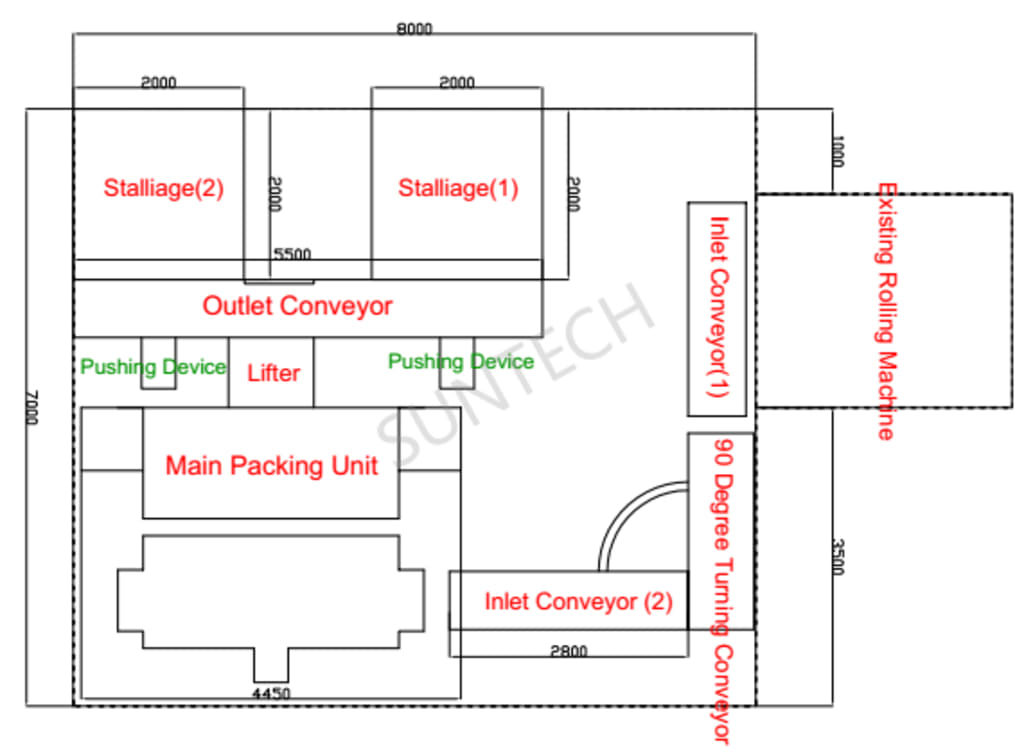
The operator put the fabric roll on the inlet conveyor. The fabric roll will be transported to the main packing machine to finish the main width sealing and side sealing, and the heat chamber will finish vacuum packing. Then, the turning conveyor will push the fabric roll to the storage table, where it will be stored.
Fabric inspection machine, fabric inlet conveyor, fabric main packing machine, fabric outlet conveyor, heat chamber, 90-degree turning conveyor, and storage stable are all part of the standard inspection and packing line from Suntech, which comes with everything you need (cloth trolley).
Using a vacuum to pack:
SUNTECH FABRIC ROLL INSPECTION&PACKING LINE is selling well in the international market because it is easy to use.
1) This is a fully automatic machine that only needs one person to use, which saves money and time.
There are two things that make this automatic fabric roll-wrapping machine very efficient: 1) It can wrap up to seven rolls per minute. It can pack up to seven rolls per minute, or about 2400-3360 every eight hours.
According to testing results, around 10% of the cost of a traditional plastic bag can be saved by switching to a paper bag.
As a general rule, one set of automatic fabric roll wrapping machine can work with up to 10 sets of inspection machines at the same time, but this isn't always the case.
5) Our fabric inspection machine price and wrapping machine prices are cheaper than those of a European company.
HOW DO YOU CHOOSE THE RIGHT FABRIC INSPECTION MACHINE FOR EACH CUSTOMER?
You can buy a lot of different types of fabric inspection machine for sale from us. As a well-known textile machine manufacturer, SUNTECH can help each customer choose the best inspection machine for their needs. SUNTECH can also figure out what kind of function the customer needs, where this machine will be used in the production process, and more.
When it comes to fabric inspection machines, some manufacturers only make standard machines. But we can make a custom design to meet the needs of each customer.
For knitted fabrics, the main thing customers want to do is control the fabric tensions and completely open the curled fabric edges so that they can be used. At the start of most knitted fabric inspection machines, there is usually a dancing roller. This roller makes sure that the speed of the fabric feeding or unwinding, checking, and rewinding are all in sync with each other.
The roller will move up and down to make sure the fabric isn't too tight. Suppose that the speed of feeding or unwinding and rewinding aren't synchronized, the potentiometer on one side of the dancing roller will send a signal to the inverters on both sides of the roller. The inverters will adjust the speed to match. After the inspection table, there is a frequency controller that can be used to change the speed of the Inspection and Rewind positions. There is a panel that shows how much tension there is and a button that lets you change the tension, too. So the operator could change the amount of tension by pressing the button.
For PVC-coated fabrics, because PVC fabrics are made of a fabric layer covered by a layer of plastic, they should not be stretched too far. This will damage the plastic layer. If you stretch the plastic layer too much, it might not be as smooth as it should be and stay striated, lose some of its shine, and even tear.
In order to protect the PVC-coated fabric, the inspection machine has a scroll roller made of aluminum, which is lighter than a normal scroll roller. Afterwards, you should make sure the fabric edges are aligned well at the edge alignment station in front of the machine so that they don't get messed up. There are cold slitting cutters for the edges of the fabric and center slitting cutters that can be used.
We specialize in making fabric make-up machines, and we know which machines work well in different factories, like weaving mills, knitting mills, and dying and finishing units. SUNTECH will help the customer choose the best machine to meet their needs. With other fabric inspection machine manufacturers, we know exactly what quality we offer and have enough faith in our machine.





Comments
There are no comments for this story
Be the first to respond and start the conversation.